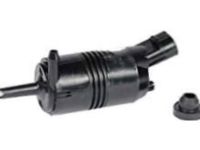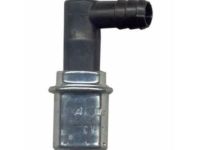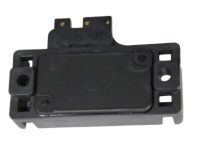- Live Chat
- 1-888-737-9766

Why choose GMPartsGiant
- Large Inventory
The best site to buy Cadillac Eldorado genuine parts for years has been GMPartsGiant.com. We're the best online parts and accessory store for your Cadillac Eldorado. GMPartsGiant.com offers a large parts and accessory inventory to cover all your vehicle's repairs. Feel free to browse through our genuine Cadillac Eldorado parts and accessory catalog to find all your vehicle's needs.
- Fast Shipping Times
All of our Cadillac Eldorado auto parts and accessories are expedited directly from verified dealers and backed by the manufacturer's warranty. Our experienced team ensures the orders are packed to provide quick transit times. The majority of the orders are shipped out within a couple of business days to get the parts out to you as fast as possible.
- Low Prices
Our low prices say it all. You can rest assured that you will always receive unbeatable prices on OEM Cadillac Eldorado parts. Our giant inventory is beyond compare and has everything you need at an extraordinary value not found anywhere else. Whether you're restoring an old vehicle or upgrading the performance of your vehicle you can count on the quality of our products without hurting your bank account.
Popular Genuine Cadillac Eldorado Parts
- Engine Parts View More >
- Front Suspension, Steering Parts View More >
- Fuel System, Exhaust, Emission System Parts View More >
- Brakes Parts View More >
- Transmission - Automatic Parts View More >
- Frames, Springs, Shocks, Bumpers Parts View More >
- Cooling System, Grille, Oil System Parts View More >
- Interior Trim, Front Seat Trim, Seat Belts Parts View More >
- Front End Sheet Metal, Heater Parts View More >
Shop Genuine Cadillac Eldorado Parts with GMPartsGiant.com
The Cadillac Eldorado, a symbol of luxury and opulence, was manufactured by Cadillac for an impressive fifty years, from 1952 to 2002, spanning twelve generations. Highly esteemed within the brand's lineup, the Eldorado was especially notable for its original 1953 convertible and the exclusive Brougham models of 1957 to 1960, with their unique bodyshells and prestigious status as the most expensive cars of their time. Post-1967, the Eldorado transitioned into a high-volume, unique two-door personal luxury car. The first generation was fitted with a robust 331 cu in (5.4 L) OHV V8 engine and 4-speed Hydra-Matic transmission, while the later eleventh generation saw the inclusion of a range of V8 engines, from a 4.1 L HT-4100 to a 4.9 L L26, paired with a 4-speed THM440-T4 automatic transmission. The 1986 Eldorado was significantly downsized, losing 16 inches in length and 350 pounds in weight, yet maintained similar interior volume and introduced framed door glass. The twelfth-generation Eldorado, launched in 1992, presented a refreshing new design and the powerful Northstar V8 engine with output varying from 270 to 295 hp. The car featured a 108-inch wheelbase, and dimensions of 202.2in in length, 75.5in in width, and 54in in height, with the length slightly reduced post-1995. Over the years, the Eldorado saw various updates, including a styling overhaul in 1995 with new bumpers, side cladding, a chrome egg-crate grille, and seven-spoke alloy wheels. The Integrated Chassis Control System was added in 1997. However, the iconic Eldorado's production ceased in 2002, marking the end of an era for this classic luxury car.
Despite its nearly half-century development and esteemed reputation, the Cadillac Eldorado inevitably faces issues with age and mileage. Common problems reported by Eldorado owners include a faulty suspension system and engine troubles. Symptoms of a deteriorating suspension system include sluggish handling, rattling or clunking noises from under the car, more pronounced squeaking over bumps, and extra damage to the front tires and brakes. The vehicle may also bottom out. Inspecting the sway bar bushing and coil spring insulator is recommended if such issues arise. Engine-related complaints include intermittent delays in throttle response, faulty cruise control, and the inability of the vehicle to maintain set speeds. Checking the throttle cable and cruise control switch for faults can help diagnose these issues. Additionally, regular maintenance of components like the windshield wiper, seat belt, and air filter is crucial to prolonging the Eldorado's lifespan.
Choosing OEM parts guarantees top-tier quality and durability. They are carefully designed to adhere to the strict specifications of the official factory and undergo thorough quality control inspections during production, ensuring long-lasting resilience and an impeccable fit. On our platform, we provide genuine Cadillac Eldorado parts, including Body Moldings, Sheet Metal, Rear Compartment Hardware, Roof Hardware, Windshield, Wiper, Mirrors, Instrument Panel, Console, Doors at incredible prices while ensuring top-tier quality. Feel at ease shopping with us, knowing our parts have a hassle-free return policy and rapid delivery service.
Cadillac Eldorado Parts Questions & Answers
- Q: How to remove and install a Washer Pump for Cadillac ElDorado and Fleetwood?A: Disconnect the negative battery cable. Drain or remove the washer solvent. Remove the headlamp access cover. Remove the radiator support brace. Remove the relay center and position it out of the way. Detach the electrical connectors and the washer hose. Unscrew the two screws and remove the solvent container. Disengage the washer pump from the solvent container. Installation is the reversal of the removal procedure. On 1992-98 Eldorado and Seville, remove the headlamp access cover. Remove the radiator support-to-wheel well brace. Remove the relay center and position aside. Use a syringe or similar tool to remove the washer fluid from the reservoir. Detach the wiring connectors and washer hose. Remove the mounting screws/nuts and remove the reservoir. Installation is the reverse of the removal procedure.
- Q: What is the purpose of a Positive Crankcase Ventilation (PCV) system and PCV Valve for Cadillac ElDorado and Fleetwood?A: Instead of venting them to the atmosphere, a positive crankcase ventilation (PCV) system is used to consume crankcase vapors in the combustion process. In gasoline engines, small amounts of combustion gas pass by the piston rings and get into the crankcase. Such crankcase blow-by gases have unwanted air pollutants, which are hydrocarbons. The PCV system is used to keep these vapors from getting away into the atmosphere while still allowing for adequate ventilation of the crankcase that ensures good oil quality. It should be checked every time you change oil and serviced every 48,000 kilometers (30,000 miles). For it can be damaged, never run an engine without a PCV valve or a ventilation system. Beginning with locating PCV valve usually found either in valve cover or intake manifold and then disconnecting the crank case ventilation tube from the positive crank case ventilation valve followed by removing the PCV valve from its grommet, install PCV valve by having it inserted into grommet with connecting ventilation tube to PCV valve.
- Q: What does the Manifold Absolute Pressure (MAP) sensor measure?A: The Manifold Absolute Pressure (MAP) sensor measures changes in intake manifold pressure, which is the difference between barometric pressure and manifold pressure. It helps the PCM adjust for different altitudes and controls fuel delivery and ignition timing. The PCM sends a 5 volt reference signal to the MAP sensor, and by monitoring the sensor output voltage, it can determine the manifold pressure. Testing involves comparing the voltage reading to a chart, backprobing the MAP connector, applying vacuum to the sensor, and checking the voltage between terminal C and ground. If the sensor and circuits are functional, the PCM may be faulty. To remove the MAP sensor, the intake manifold top cover is removed, the crankcase breather tube is disconnected, and the sensor is detached from the intake manifold. The MAP sensor grommet should be inspected and replaced if necessary. Installation is the reverse of the removal procedure.



















































